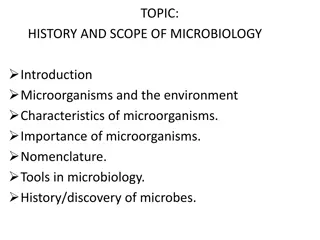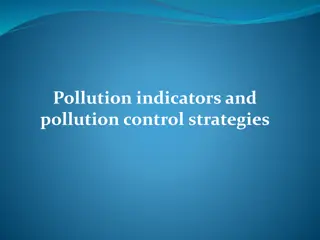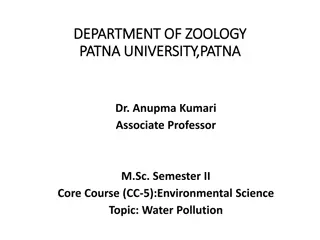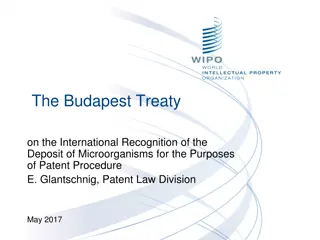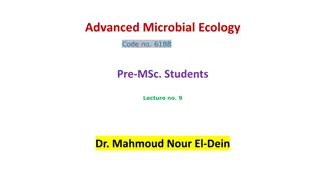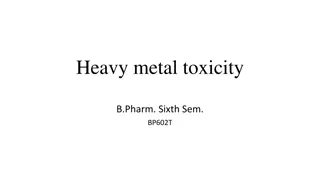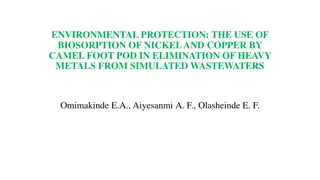The Role of Microorganisms in Mitigating Heavy Metal Pollution
Metal pollution poses health and ecological risks globally, with heavy metals like mercury and lead causing various harmful conditions. Microorganisms play a crucial role in altering the bioavailability and toxicity of metals. By converting elemental mercury to methylmercury and affecting the valence state of metals, microorganisms help reduce the danger of heavy metal contamination in the environment.
Download Presentation

Please find below an Image/Link to download the presentation.
The content on the website is provided AS IS for your information and personal use only. It may not be sold, licensed, or shared on other websites without obtaining consent from the author. Download presentation by click this link. If you encounter any issues during the download, it is possible that the publisher has removed the file from their server.
E N D
Presentation Transcript
Microorganisms and Metal Pollutants Environmental Microbiology /Undergraduate /Biology Dr Thana Noor
Microorganisms and Metal Pollutants: Metal pollution is a global concern. The levels of metals in all environments, including air, water, and soil, are increasing, in some cases to toxic levels, with contributions from a wide variety of industrial and domestic sources for example, anthropogenic emissions of lead , cadmium, vanadium, and zinc exceed those from natural sources by up to 100- fold 100 Metal-contaminated environments pose serious health and ecological risks. Metals such as aluminum, antimony, arsenic, cadmium, lead, mercury, and silver cause conditions including heart disease, liver damage, cancer, neurological and cardiovascular disease, central nervous system damage, encephalopathy, hypophosphatemia, and sensory disturbances. . . . . Environmental Microbiology /Undergraduate /Biology Dr Thana Noor
What role do microorganisms play in reducing the danger of heavy metals like mercury? microbial activity in the sediment converted elemental mercury into the highly toxic and bioavailable methylmercury. Which accumulated in fish. Lead is a second metal of concern because lead poisoning of children is common and leads to retardation and semi- permanent brain damage. Because metal availability is strongly dependent on environmental components, such as pH, redox, and organic content, there is often a discrepancy(conflict ) between the total and bioavailable amount of a metal present. In environmental samples, and a bioavailable metal is generally soluble and not soluble to colloids on soil surfaces. Metals cannot be degraded through any physical, chemical or biological means, including microorganisms. However, microorganisms can alter the bioavailability of metals and their potential toxicity by changing the valence state of specific metals through oxidation or reduction. Environmental Microbiology /Undergraduate /Biology Dr Thana Noor
Metals defined There are three classes of metals: 1- Metals. 2- Metalloids. 3- Heavy metals. Metals, in general, are a class of chemical elements that form lustrous solids that are good conductors of heat and electricity. However, not all metals fit this definition; for example, mercury is a liquid. Elements such as arsenic, boron, germanium, and tellurium are generally considered metalloids or semimetals in that their properties are intermediate between those of metals and those of nonmetals. Heavy metals are defined in a number of ways based on cationic hydroxide formation, a specific gravity greater than 5 g/ml, complex formation, hard soft acids and bases, and, more recently, association with eutrophication and environmental toxicity. Eutrophication which occurs when the environment becomes enriched with nutrients, increasing the amount of plant and algae growth to estuaries waters. and coastal Environmental Microbiology /Undergraduate /Biology Dr Thana Noor
As a result of the complexity of the chemical definitions, metals have also been categorized into three additional classes on the basis of their biological functions and effects: 1) The essential metals with known biological functions. 2) The toxic metals and metalloids. 3) The nonessential metals with no known biological effects. Mention the metals that are currently known to have essential functions in microorganisms: Na, K, Mg ,Ca, V,Mn, Fe , Co , Ni , Cu ,Zn, Mo ,and W . Chromium is also thought to be essential, although this is still in dispute . Metals such as Na, K, Mg, and Ca are required by all organisms. Tungsten (W) essential only in hyper thermophilic bacteria, such as Pyrococcus furiosus , found in hydrothermal vents . Tungstate is thought to replace molybdate in these environments. In general, essential metals are required for enzyme catalysis, molecule transport, protein structure, charge neutralization, and the control of osmotic pressure. The toxic metals include those with no known biological function. These include Ag, Cd, Sn, Au,Hg,Tl,Pd, Al, and metalloids Ge, As , Sb ,and Se. Metals are predominantly present as cationic species, and metalloids are predominantly present as anionic species. , on the other hand, appears to be Environmental Microbiology /Undergraduate /Biology Dr Thana Noor
Metal bioavailability in the environment: Metal in the environment can be divided into two classes 1- Bioavailable (soluble, non sorbed and mobile). 2- Nonbioavailable (precipitated, complexed, Sorbed and nonmobile). Soils usually exhibit higher concentrations of metals than waters because metals are more likely to accumulate in soil versus being diluted or carried elsewhere in water, and soils are composed of minerals which can naturally contain high concentrations of metals. Soil organic matter contains both humic and non humic substances , Humic substances contain a variety of organic functional groups that are able to interact with metals. These functional groups include carboxyl, carbonyl, phenyl, hydroxyl, amino, imidazole, sulfhydryl, and sulfonic groups. Metals complexed with humic substances are generally not bioavailable and therefore are less toxic to biological systems. . . . . Environmental Microbiology /Undergraduate /Biology Dr Thana Noor
Metals cannot be degraded through any physical, chemical or biological means, including microorganisms. However, microorganisms can alter the bioavailability of metals and their potential toxicity by changing the valence state of specific metals through oxidation or reduction. Metal toxicity effects on the Microbial Cell: Due to ionic interactions, metals bind to many cellular ligands and displace essential metals from their normal binding sites. For example Cadmium can replace zinc in the cell. Metals also disrupt proteins by binding to sulfhydryl groups. Disrupt nucleic acid by binding to phosphate or hydroxyl group. As a result protein and DNA. These metal microbe interactions result in decreased growth, abnormal morphological changes, and inhibition of biochemical processes in individual cells. The toxic effects of metals can be seen on a community level as well. Environmental Microbiology /Undergraduate /Biology Dr Thana Noor
Mechanisms of Microbial Metal Resistance and Detoxification Microorganisms are believed to have evolved metal resistance because of Their exposure to toxic metals on early Earth. Anthropogenic contamination of the environment with metals. Microorganisms have evolved ingenious mechanisms of metal resistance and detoxification in response to metals in the environment. Many of the resistance determinants are encoded on the chromosome but some are encoded on mobile genetic elements such as plasmids and transposons. Transposons : a chromosomal segment that can undergo transposition segment of bacterial DNA that can be translocated chromosomal, phage, and plasmid DNA in the absence of a complementary sequence in the host DNA. , especially a as a whole between Environmental Microbiology /Undergraduate /Biology Dr Thana Noor
Microbial metal resistance mechanisms: 1. Volatilization 2. Exopolysaccharide EPS sequestration What is the function of EPS in bacteria? Exopolysaccharides (EPS) are extracellular macromolecules excreted as tightly bound capsule or loosely attached slime layer in microorganisms. They play most prominent role against desiccation , phagocytosis , cell recognition toxic compounds and osmotic stress 1. Efflux pumps 2. Precipitation as metal salts 3. Outer membrane or cell wall binding 4. Reduction 5. Biosurfactant complexation , phage attack, antibiotics or Environmental Microbiology /Undergraduate /Biology Dr Thana Noor






